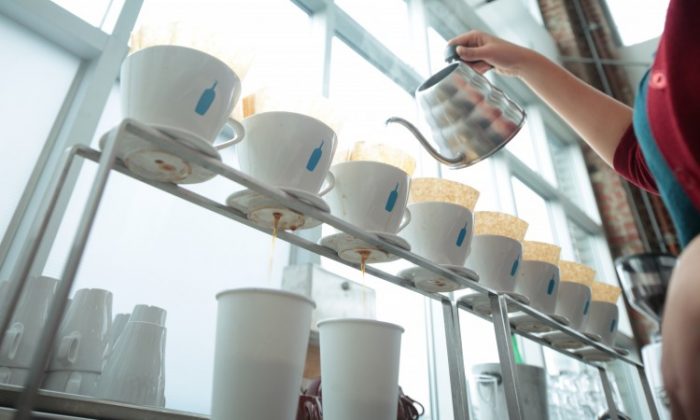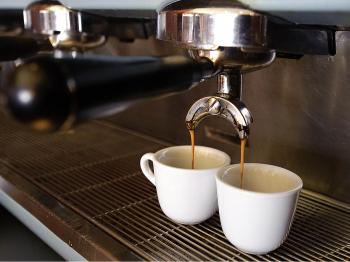
Coffee Is for Everyone
SAN FRANCISCO — According to legend, we owe many delicious things to the Battle of Vienna, such as the creation of the croissant, the bagel, and the spreading of coffee. Franz George Kolshitsky, as it goes, brought bags of coffee that the Viennese troops obtained from the Turks back to Vienna, opened the first coffee house in Central Europe, and may have invented the cappuccino.
Whether that holds any truth or not, the popularization of the drink is a feat that James Freeman admires. Freeman, founder of the dual-coast roastery Blue Bottle Coffee, is also the man behind the $20,000 cup of coffee.
Blue Bottle, named after Kolshitsky’s café, started as a coffee cart in the Hayes Valley neighborhood of San Francisco when then-musician Freeman decided to hang up his clarinet and pursue another craft instead. Blue Bottle’s mission is to sell coffee no older than 48 hours out of the roaster, at its peak flavor.
“You come into Blue Bottle and there’s no straws for your latte, no whipped cream, no vanilla flavors, all these flavors—there’s nothing but a fantastic drink, whether it’s plain espresso, or a drip cup of coffee, whatever it is,” said coffee enthusiast Pamela Snyder.
It’s a well-known success story among those who drink coffee, as it seems that everyone who has will tell you that Blue Bottle pulls “the best espresso you’ve ever tasted” and everyone who hasn’t hears the same.
The company, founded in 2002, is recently under new ownership with a $20 million investment, but Freeman still remains very much involved in running Blue Bottle.
Blue Bottle Coffee continues to expand, with an opening at New York’s Rockefeller Plaza; the launch of a cold-brew bottled coffee line; and “The Blue Bottle Craft of Coffee,” penned by Freeman, his wife and Miette patisserie co-founder Caitlin Freeman, and friend and food writer Tara Duggan this past fall.
The book, a comprehensive and amusing introduction to coffee, aims to be “a nice, accessible thing that people who like good food, who appreciate good food, would like about coffee,” Freeman said.
“Things excite me, I love certain things, and I want to bring them to people,” Freeman said of his coffee philosophy. “It’s not about being right; it’s about being good.”
One of the coffee brewing techniques that he finds exciting is the Japanese style of brewing coffee—which Freeman says he can talk about all day.
Roasters owe many of their techniques to Japanese brew-ware. Japan imports 930 million pounds of coffee a year, and manufactures grinders, drippers, and kettles responsible for the pour-over method and slow-drip cold brew—and these terms are increasingly making their way into the vocabulary of the average coffee drinker.
The attention to technique in recent years was made possible by the rise of specialty coffees that began decades ago, with “gourmet” coffees becoming popularized in the early 1980s.
“One of my sons got a Krups grinder at his school, and he gave it to me. It was a wonderful grinder, and we wore it out. This was the early ’80s. I realized that when you bought different beans, your coffee tasted different!” Snyder said.
1. Gourmet Coffee
Joel is a college student. He doesn’t drink coffee; he prefers soft drinks.
Joel is an imagined demographic from the mind of Kenneth Roman Jr., former CEO of Ogilvy and Mather, the advertising and press relations company that carried Maxwell House in the 1980s.
“We don’t know what to do about Joel,” Roman had said.
You’ll be hard-pressed to find a college student who doesn’t drink coffee these days, thanks to decades of marketing.
In 1830, annual per capita consumption of the bean was at three pounds. By 1930, coffee was an inexpensive and staple drink due to the industrialization and revolution in food processing and production, leading to “coffee breaks” taken at every factory.
Anthropology professor William Roseberry outlined the relationship between class and coffee post-World War II in his article “The Rise of Yuppie Coffees and the Reimagination of Class in the United States,” published in 1996 in American Anthropologist.
The trend had been toward cheaper prices until the July 1975 frost in Brazil. Coffee treaties had been signed internationally by producers and consumers of coffee, requiring a certain export quota from the producers. Suddenly, no one wanted to buy the tasteless bags of coffee that were priced nearly as high as the previously expensive gourmet choices in supermarkets.
Retailers saw this, and strategies were drastically changed. Roasters like Starbucks from Seattle expanded aggressively, paving the way for the dense concentration of West Coast roasters to get their name out.
The Specialty Coffee Association of America (SCAA) formed in 1982 to lobby the government, speak for trade, and identify economic and political trends. Shortly after its formation, SCAA appealed for a $1.6 million grant to promote specialty coffees, targeting the “Joel” demographic.
The United States consumption of coffee jumped from 14 million in 1980 to 40 million in 1983, and by 1986 it was a $500 million industry.
“I am a second generation coffeeman, and through direct experience, remember when there was a certain pride in the coffee business,” Alan Rossman of Hena Estate Grown Coffee explained to World Coffee and Tea in 1981, as quoted by Roseberry in his article.
Rossman noted his dismay as the industry quickly became about price, until that year. “All of a sudden … comes along somebody who’s interested in quality. He doesn’t care that he may have to sell it at twice the price of canned coffee, he’s only interested in quality. All we’re doing today is copying what our fathers and grandfathers did years and years ago.”
Choices, varieties in taste and style, were applied to a previously monotonous commodity, and as specialty coffees became the norm, the varieties were increasingly standardized. Coffee wasn’t just from Blue Mountain; it was “Blue Mountain style,” or “Mocha style.” Non-natural characteristics like secondary flavoring ensured that every line had a vanilla, a hazelnut, and so on. And coffee has come full circle.
2. Quality
A $20,000 Kyoto-style siphon bar sits in Blue Bottle Coffee’s Mint Plaza location in San Francisco—it’s a process that takes over 12 hours to produce a dense, sweet cup of coffee. Drip coffee is hand-poured by a friendly barista at each of the locations’ drip bars.
“We have a cupping room and a quality control department, and we’re always cupping different things and doing tests and different experiments on what we’re excited about,” Freeman said.
“I like delicious things. And I don’t like to be doctrinaire—I have some things I believe, but I also don’t believe in certainty, I don’t believe in correctness,” Freeman said. “I think there are a lot of really great and interesting ways to appreciate coffee.”
Freeman encourages people to brew coffee at home, to learn the ins-and-outs of what goes into the cup, and why your coffee tastes different.
“To just make it simple like this, make it something beautiful and simply at home, I think it’s great,” Freeman said.
“I’ve always loved it. I’ve just always been into coffee, ever since I begged my parents to let me open the can of coffee,” Freeman said. “I just like it so much. I feel lucky.”
by Catherine Yang






